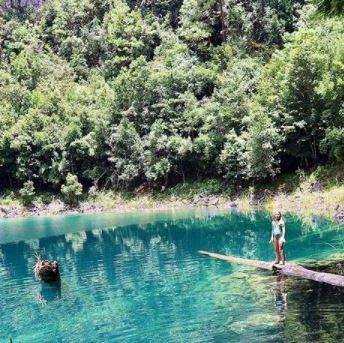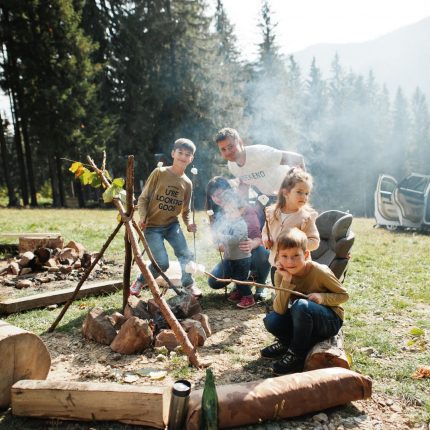
World Schooling: Teaching Kids Indigenous Cultures
October 9, 2020Guest post by the Culture Trotters.
Spoiler alert: we found paradise.
Not the “too-good-to-be-true” tropical beach that makes fabulous postcards but a lousy home. We found the “perfect place to visit, perfect place to live, I want to stay forever” kind of paradise.
While anxiously waiting out the lockdowns, we have spent the last 2-3 months in San Cristobal de las Casas, a quaint little colonial town in the mountains of Chiapas Mexico. It would be easy to talk about the great mountain weather, the extremely affordable lifestyle, the small shops and eateries, and how crazy friendly everyone is. (I have had people stop at a green light just to let me cross with my kids.) But the really unique world-schooling advantage exists just minutes away on the mountainous slopes.
The town is surrounded by villages of indigenous people with many different tribal heritages, all from the Maya civilization. Each tribe is unique as their cultures were influenced differently over the years. Not only their original tribal traditions, but changes as each were controlled by the Maya, Aztecs, Spanish, or some other neighboring tribe. They practice their own religions, which are a hybrid of Maya and Catholic beliefs. (Word of the Day: syncretism, “the mixture of one or more religion.”)
Their towns are referred to as “autonomous.” While still part of Chiapas, they are given much more leeway in how they run their town, and what laws and punishments they enforce. They speak their own languages and wear their own traditional clothing. Even towns just a few miles apart may have a unique look and sound. Most of these communities specialize in different traditional hand crafts that they come to San Cristobal to sell. When walking through town, you will see the very young to the very old selling their goods on the streets and weighed down with more than anyone should carry.
We were fortunate to frequent three different towns so our kids could experience their cultures firsthand.
Zinacantán
Zinacantán is well known for its flowers. On the ride up the mountain you can see greenhouse after greenhouse. Not only do they grow flowers but they show their love for them through their clothing. Both the men and the women wear bright red and purple woven fabric heavily embroidered with flowers. One of our visits was during the celebration of their patron Saint, San Lorenzo. The whole town was out showing off their beautiful clothing and the church was dripping in fresh flowers.
One of the things we really enjoyed is how they were just as curious about us as we were about them. They don’t get all that many visitors in their town. Particularly not a 6’4” bearded man, a long-haired boy with bright red hair, and a little blonde girl wearing one of their traditional dresses. Instead of us asking to take photos of them they were pulling out their phones and asking to take photos with us. (And yes, it was a bit bizarre watching an old woman in completely traditional dress, whip out the latest phone to snap some pictures.) I guess I wasn’t that exotic looking to them because I was the one asked to snap the photos.
Right outside of our Airbnb, there were three women who would come every day from Zinacatán to sell roses in San Cristobal. Every morning, we walked out the door to see their smiling faces and the scent of hundreds of roses. These women loved our kids and our kids loved them. Arabella would often sit outside with them and they would braid her hair and teach her words in Tzotzil, their indigenous language. The ladies would often pass the kids roses through their bedroom window and the kids would color them little pictures and thank you notes. When it rained, which it did almost every day, the kids would invite them to come in until the rain passed. These ladies truly became our neighbors, and showed us that despite being so different from us, we really are all the same.
Chamula
Chamula is the more mysterious of the two Tzotzil towns. The women wear long, black, shaggy sheep wool skirts, and the men wear white, shaggy sheep wool vests. Unlike their Zinacantán neighbors these people are not into photographs. So much so that if you pull out a camera, they will immediately hide their face or leave the room. They believe the camera damages their soul.
We visited their town on two different occasions. Once was for visiting their bustling market day and another time was for visiting San Juan, their “burping” church. You heard me right, through some mixture of time, religious beliefs, and marketing, these people take bottles of Coca-Cola to church with them, drink it, and burp it out as a form of cleansing the soul. Imagine trying to teach your 7- and 9-year-old how to be culturally respectful in a situation like that… We are actually quite proud of them for keeping it together.
We were able to arrange for a Chamulan woman to come to our house and teach Arabella and me their technique for embroidery. Arabella just adored her teacher and we made a point to visit her shop in the Santo Domingo market for a few going-away hugs before leaving town.
Learn indigenous embroidery techniques.
Amantenango de valle
Amantenango is all about the women. From the Tzeltal tribe, they wear slightly shorter tea-length pleated skirts, white ruffled blouses, and a colorful apron over top. The women of Amantenango are famous for their clay sculptures. You can’t leave Chiapas without one of their hand sculpted jaguars or doves. Every year during the dry season, the women head off to the same place in the mountains that they have been going to for generations to collect their clay allotment for the whole year. Everyone’s home is also a clay workshop where they mold, fire, and paint their sculptures.
We were fortunate enough to get to visit one of these homes and try our hand at making our own sculptures. While the kids loved getting their hands messy, none of us showed any natural talent. That didn’t stop us, or our teacher Albertina, from having a great time and a lot of laughs.
In addition to our lesson, she and her sister Maria made us breakfast, and coffee harvested right from the tree in their yard. Alejandro and Arabella found it a little hard to focus on the history lesson since Albertina’s dog had three little puppies. They were adorable and the kids just couldn’t resist playing with them!
We are so thankful for our time in Chiapas and being able to share it with these unique and amazing people. While we enjoyed the experience, it is time to move on to our next adventure. After 7 months of quarantine, Mexico-style, we now begin our very long trip. We will encounter two gulfs, two oceans, and four continents on our way to Tanzania, Africa.
Join us next month to see what new adventures Tanzania brings our world-schooled children!
The Esteves family has recently started world-schooling full time. They live more like locals and less like tourists in an effort to give their kids a more unique and in-depth cultural experience. Share in the adventures on their educational and always entertaining YouTube channel Culture Trotters Get daily photos of their experiences on Instagram @culturetrotters.
Latest Posts

As homeschooling continues to grow in popularity, more parents are taking on the challenge of providing a comprehensive education that not only meets academic standards but also prepares their…
Read more >
June has come and gone, and summer is in full swing! Whether you're traveling this summer or staying close to home, we hope you're enjoying this time with your family. We wanted this month's…
Read more >
Summer is an all-around favorite season for most people. In the U.S., it’s even more exciting for many of us since we get to celebrate Independence Day! The Fourth of July is a wonderful…
Read more >

